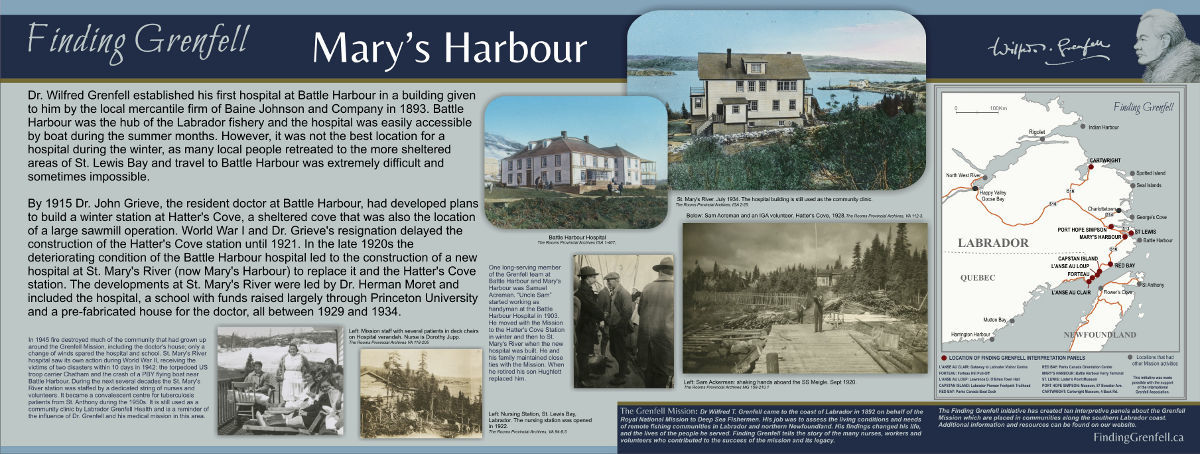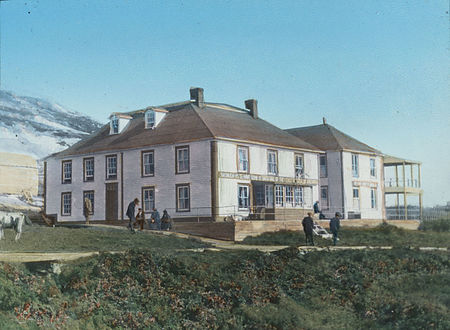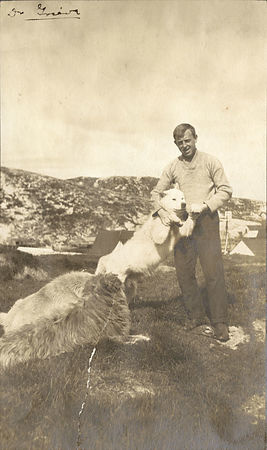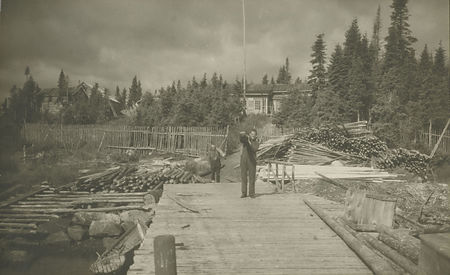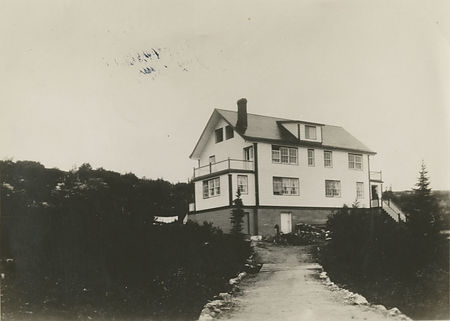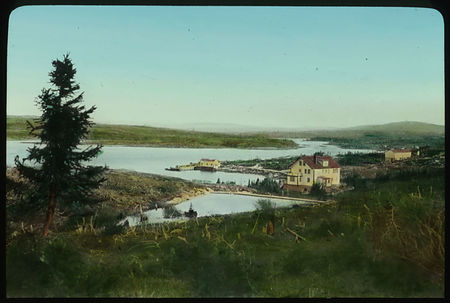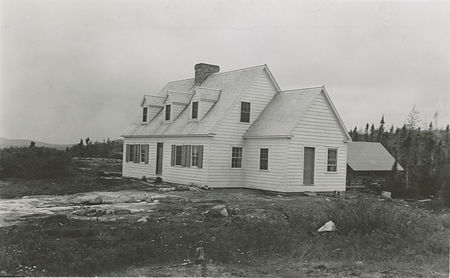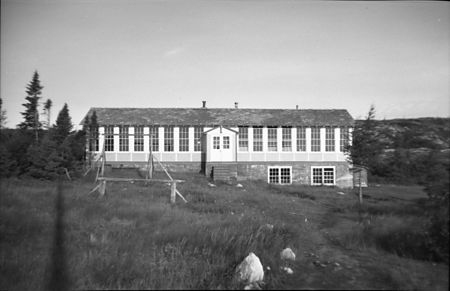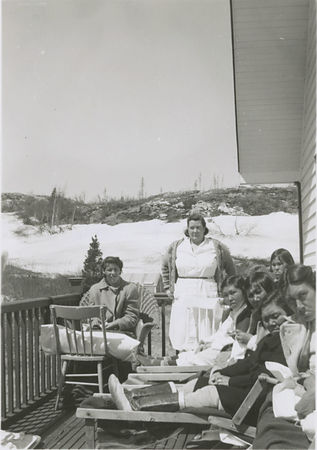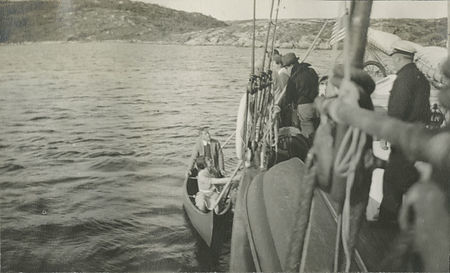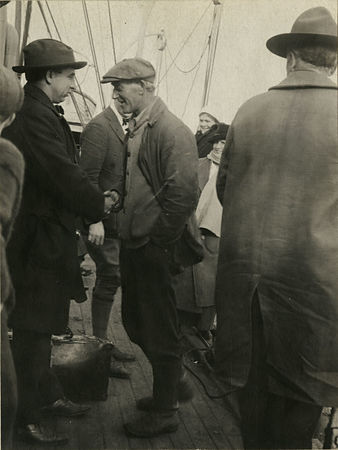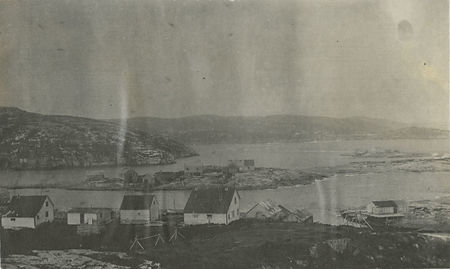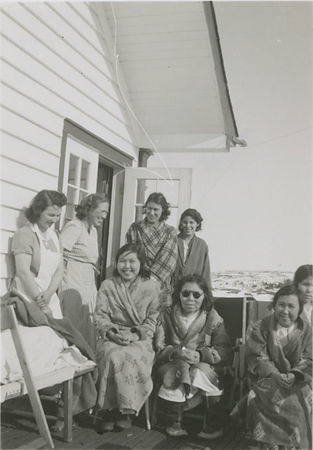Mary's Harbour
Note: The present-day town of Mary's Harbour was previously called St Mary's River.
Dr. Wilfred Grenfell first arrived in Labrador in 1892; he was working with the Royal National Mission to Deep Sea Fishermen to assess the condition of the fishermen in the area of Northern Newfoundland and the coast of Labrador. He determined almost immediately that medical services were required. In 1893 he started his first hospital at Battle Harbour in a building given to him by Baine Johnson and Company, the St. John's-based merchants that operated there.
Battle Harbour was the hub of the Labrador fishery and easily accessible during the summer months. It was not, however, the best location for a hospital during the winter. By 1915 Dr. John Grieve, resident physician at Battle Harbour, had created plans to build a winter headquarters for the Grenfell Mission at Hatter's Cove in St. Lewis Bay.
In addition to being a sheltered location on the mainland that was easily accessible, Hatter's Cove was the site of a large sawmill operation run by Conception Bay merchant George Sellars. The war and the resignation of Dr. Grieve resulted in delays and the Hatter's Cove station did not get built until 1921, and then with the help of Sellars and the local people. An appeal by Dr. Grenfell raised an additional 1000.00 for the station.
The Battle Harbour and Hatter's Cove hospitals continued to operate until 1929. The old Battle Harbour facility was in a bad state of repair and a decision was made under the guidance of Dr. Herman Moret to construct a new hospital on the mainland to replace it and the Hatter's Cove hospital. Much of the equipment had been moved to the new facility at St. Mary's River (present-day Mary's Harbour) when the Battle Harbour hospital was destroyed by fire in November 1930.
In 1931 a school was constructed at St. Mary's River with funds raised largely through Princeton University, for which the school was named. It took both day students and boarders. A prefabricated house was purchased from Sears Roebuck in the United States and shipped to Mary's Harbour, where it was erected on the hill overlooking the harbour to serve as living quarters for the doctors, which were stationed at Mary's Harbour until the 1940s. In 1945 it and most of the other buildings at Mary's Harbour were destroyed by a large forest fire. The hospital and the Princeton School were spared by a change of wind.
Nurse Dorothy Jupp was in charge of the hospital during the crises of the fire; she was also at St. Mary's River, along with Dr. Helen Hosmer, during the eventful war-time summer of 1942. In the space of 10 days the St. Mary's River hospital received victims of two catastrophic events.
The first were burn victims from the American troop carrier Chatham, which was torpedoed off Henley Harbour in the Strait of Belle Isle. Next came the victims of the crash of a PBY flying boat near Battle Harbour after it took off from the American Loran A site at White Point. While assisting Dr. Hosmer with the extraction of a particularly stubborn tooth, Nurse Jupp witnessed the burst of flame and cloud of smoke on the horizon when the plane exploded.
During the 1950s many of the tuberculosis patients from St. Anthony were sent to St. Mary's River for rest and convalescence. In the words of Dr. Charles S. Curtis, "It is a delightful place for patients recovering from serious illness."
The hospital at Mary's Harbour continues to be used as the local clinic by Labrador Grenfell Health and is a reminder of the influence of Sir Wilfred Grenfell in this area.
The history of the Battle Harbour Hospital, the St. Lewis Bay winter station at Hatter's Cove and the early years of the St. Mary's River Hospital have one person in common: Samuel Acreman. Uncle Sam, as he was known, was born in Bay Roberts, Newfoundland in 1878. His family was connected to Battle Harbour and in 1903 he started working as handyman at the Battle Harbour Hospital.
Uncle Sam owned a small saltbox house at the north end of Battle Harbour. In 1923 the Grenfell Mission helped him to enlarge his house so that he could accommodate visitors to Battle Harbour, namely many of the Mission workers who had to wait at Battle Harbour for connecting steamers.
When the new hospital was built at St. Mary's River Uncle Sam and his family moved too. In fact, he had no house at St. Mary's River the first winter of 1929 so he and his family lived on board the steam launch Jennie Foote, which was moored in the harbour.
Further Reading
Diack, Lesley. Labrador Nurse: Three years with the Grenfell Mission in one of the most sparsely populated areas of the world. London: Victor Gollancz Ltd., 1963.
References
Monroe T. Gilmour was a volunteer at the Battle Harbour Hospital during the summer of 1930. He wrote of the building of the new hospital at Mary's Harbour in "St. Mary's River," Among the Deep Sea Fishers, Vol 28(4), January 1931, pp. 175-78.
http://collections.mun.ca/cdm/compoundobject/collection/hs_fisher/id/8880/rec/110
Melancthon W. Jacobus, Jr. was a volunteer at Mary's Harbour in the summer of 1931. He wrote of building the Princeton School there in "Last Summer's Outdoor Work at St. Mary's River," Among the Deep Sea Fishers, Vol 30(1), April 1932, pp. 21-23.
http://collections.mun.ca/cdm/compoundobject/collection/hs_fisher/id/4789/rec/115
Alice L. Toops wrote of her experiences teaching at the newly built Princeton School at St. Mary's River during the winter of 1931-32 in "The St. Mary's River School: Winter of 1931 and '32," Among the Deep Sea Fishers, Vol 31(2), July 1933, pp. 79-84.
http://collections.mun.ca/cdm/compoundobject/collection/hs_fisher/id/9047/rec/120
Charles Stanley Knapp, MD wrote of the winter of 1923 at Hatter's Cove, the winter quarters of the Battle Harbour hospital in "Hatter's Cove: Battle Harbour Winter Station," Among the Deep Sea Fishers, Vol 22(3), October 1924, pp. 105-07.
http://collections.mun.ca/cdm/compoundobject/collection/hs_fisher/id/4259/rec/85
In letters nurse Violet F. Edwards and George Sellars, owner of a saw milling operation at Hatter's Cove, wrote of the establishment of the St. Lewis Bay Nursing Station at Hatter's Cove in Among the Deep Sea Fishers, Vol 20(2), October 1922, pp. 75-77.
http://collections.mun.ca/cdm/compoundobject/collection/hs_fisher/id/448/rec/77
Harry L. Paddon. MD wrote of the initial plan to build a winter quarters for Battle Harbour at St. Lewis Bay in his report "Progress and Ambition 'Down North,'" Among the Deep Sea Fishers, Vol 18(4), January 1921, pp. 160-61.
http://collections.mun.ca/cdm/compoundobject/collection/hs_fisher/id/3877/rec/71
Sir Wilfred Grenfell wrote of the establishment of the St. Lewis Bay Nursing Station during the winter of 1920-21; Nurse Dorothy Dohme wrote of her experience at the station that first winter. Both can be found in Among the Deep Sea Fishers, Vol 19(2), July 1921, pp. 58-60.
http://collections.mun.ca/cdm/compoundobject/collection/hs_fisher/id/3795/rec/73
Elizabeth W. Delatour wrote of the summer that she and her family spent at St. Mary's River in 1945, including the fire that ravaged to community, which was burning when they arrived, in "Summer at St. Mary's," Among the Deep Sea Fishers, Vol 43(4), January 1946, pp. 104-06.
http://collections.mun.ca/cdm/compoundobject/collection/hs_fisher/id/12067/rec/170
Nurse Dorothy Jupp wrote about the fire that destroyed much of St. Mary's River in 1945 in "Holocaust at St. Mary's," Among the Deep Sea Fishers, Vol 43(3), October 1945, pp. 68-69. The piece is accompanied by a letter from Dr. Robert Miller describing how well Nurse Jupp handled the situation.
http://collections.mun.ca/cdm/compoundobject/collection/hs_fisher/id/10205/rec/45
Dr. Helen Hosmer's account of the catastrophic events of the summer of 1942 near St. Mary's River can be found in "War Comes to Labrador," Among the Deep Sea Fishers, Vol 41(2), July 1943, pp. 35-37.
http://collections.mun.ca/cdm/compoundobject/collection/hs_fisher/id/9909/rec/160
Dr. Helen Hosmer describes her experiences at St. Mary's River during 1940 in "At St. Mary's River," Among the Deep Sea Fishers, Vol 39(1), April 1941, pp. 9-10.
http://collections.mun.ca/cdm/compoundobject/collection/hs_fisher/id/9565/rec/24
Evelyn V. Halstead wrote of her visit with Dr. and Mrs. Moret at St. Mary's River during the summer of 1934 in "A Visit to St. Mary's," Among the Deep Sea Fishers, Vol 33(3), October 1935, pp. 91-93.
http://collections.mun.ca/cdm/compoundobject/collection/hs_fisher/id/11334/rec/129
